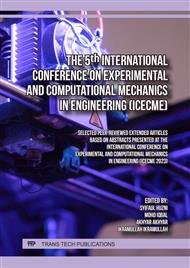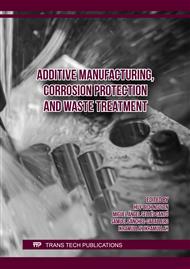[1]
A. G. Olabi et al., "Renewable energy systems: Comparisons, challenges and barriers, sustainability indicators, and the contribution to UN sustainable development goals," International Journal of Thermofluids, vol. 20, p.100498 (2023)
DOI: 10.1016/j.ijft.2023.100498
Google Scholar
[2]
United Nations, "The 2030 Agenda for Sustainable Development's 17 Sustainable Development Goals (SDGs)," p.10–15 (2015)
Google Scholar
[3]
R. Adriman, I. Bin M. Ibrahim, S. Huzni, S. Fonna, and A. K. Ariffin, "Improving half-cell potential survey through computational inverse analysis for quantitative corrosion profiling," Case Studies in Construction Materials, vol. 16, (2022)
DOI: 10.1016/j.cscm.2021.e00854
Google Scholar
[4]
M. Roi, D. Asriwiyanti, W. Hendry, S. Deni, and H. Ginardy, "Assessment of Seismic Vulnerability of School Buildings: A case study in Bandung, West Java, Indonesia," Disaster Adv., vol. 16, p.49–59, (2023)
DOI: 10.25303/1609da049059
Google Scholar
[5]
H. Song and V. Saraswathy, "Corrosion Monitoring of Reinforced Concrete Structures - A Review," International Jurnal of Electrochemical Science, vol. 2, p.1–28, (2007)
DOI: 10.1016/s1452-3981(23)17049-0
Google Scholar
[6]
V. Rajendran and R. Murugesan, "Performance of the sacrificial galvanic anodes in rehabilitation of marine structure at port blair , andaman and nichobar islands , india," Journal of Structural Engineering, vol. 6, p.45–55, (2011)
Google Scholar
[7]
A. Bahadori, 3 - Design considerations on cathodic protection for buried pipelines and marine structures., Cathodic Corrosion Protection Systems. Elsevier, (2014)
DOI: 10.1016/b978-0-12-800274-2.00003-x
Google Scholar
[8]
V. Leelalerkiet, J.-W. Kyung, M. Ohtsu, and M. Yokota, "Analysis of half-cell potential measurement for corrosion of reinforced concrete," Construction and Building Materials., vol. 18, no. 3, p.155–162, (2004)
DOI: 10.1016/j.conbuildmat.2003.10.004
Google Scholar
[9]
M. Ridha, S. Fonna, S. Huzni, and a. K. Ariffin, "Corrosion Risk Assessment of Public Buildings Affected By the 2004 Tsunami in Banda Aceh," Journal of Earthquake and Tsunami, vol. 07, p.1350004, (2013)
DOI: 10.1142/s1793431113500048
Google Scholar
[10]
H. Z. Lopez-Calvo, P. Montes-García, V. G. Jiménez-Quero, H. Gómez-Barranco, T. W. Bremner, and M. D. A. Thomas, "Influence of crack width, cover depth and concrete quality on corrosion of steel in HPC containing corrosion inhibiting admixtures and fly ash," Cement and Concrete Composite., vol. 88, p.200 – 210, (2018)
DOI: 10.1016/j.cemconcomp.2018.01.016
Google Scholar
[11]
K. Hornbostel, C. K. Larsen, and M. R. Geiker, "Relationship between concrete resistivity and corrosion rate – A literature review," Cement and Concrete Composite., vol. 39, p.60 – 72, (2013)
DOI: 10.1016/j.cemconcomp.2013.03.019
Google Scholar
[12]
L. Sadowski, "New non-destructive method for linear polarisation resistance corrosion rate measurement," Archives of Civil and Mechanical Engineering., vol. 10, p.109–116, (2010)
DOI: 10.1016/s1644-9665(12)60053-3
Google Scholar
[13]
K. Minagawa, K. Suga, M. Kikuchi, and S. Aoki, "An efficient inverse analysis considering observation error to detect corrosion in concrete structures containing multilayered rebar," International Journal of Mechanics and Material in Design., vol. 8, p.81–87, (2012)
DOI: 10.1007/s10999-012-9178-6
Google Scholar
[14]
L. C. Wrobel and P. Miltiadou, "Genetic algorithms for inverse cathodic protection problems," Engineering Analysis with Boundary Element, vol. 28, p.267 – 277, (2004)
DOI: 10.1016/s0955-7997(03)00057-2
Google Scholar
[15]
D. T. Kalovelonis, T. V Gortsas, and S. V Tsinopoulos, "Modelling of 3D periodic cathodic protection problems in reinforced concrete structures with accelerated boundary element method," Construction and Building Materials, vol. 394, p.132211, (2023)
DOI: 10.1016/j.conbuildmat.2023.132211
Google Scholar
[16]
G. H. Kim et al., "Recent progress on microelectrodes in neural interfaces," Materials (Basel)., vol. 11, no. 10, (2018)
Google Scholar
[17]
A. Baudler, I. Schmidt, M. Langner, A. Greiner, and U. Schröder, "Does it have to be carbon? Metal anodes in microbial fuel cells and related bioelectrochemical systems," Energy & Environmental Science., vol. 8, no. 7, p.2048–2055, (2015)
DOI: 10.1039/c5ee00866b
Google Scholar
[18]
Alva, A. S. Binti Abdul Aziz, M. I. Bin Syono, and W. A. Bin Wan Jamil, "Ag/AgCl reference electrode based on thin film of arabic gum membrane," Indonesian Journal of Chemistry., vol. 18, no. 3, p.479 – 485, (2018)
DOI: 10.22146/ijc.28859
Google Scholar
[19]
M. Ihsan, S. Fonna, S. Huzni, N. Islami, and A. K. Ariffin, "Cu/CuSO4 Solid-State Reference Electrode for Potential Corrosion Measurement on the Reinforcing Steel," in Proceedings of the 3rd International Conference on Experimental and Computational Mechanics in Engineering, p.328 – 339, (2023)
DOI: 10.1007/978-981-19-3629-6_34
Google Scholar
[20]
M. Ihsan, S. Fonna, M. Ridha, S. Huzni, and a. K. Ariffin, "The Influence of Anode Profiles for Three Dimensions Numerical Simulation of Reinforced Concrete Corrosion Using Boundary Element Method," Advanced Materials Research., vol. 686, p.261 – 265, (2013)
DOI: 10.4028/www.scientific.net/amr.686.261
Google Scholar



